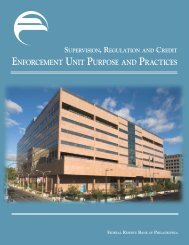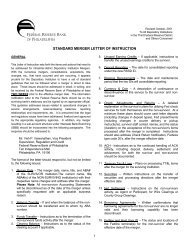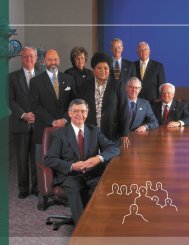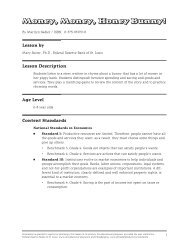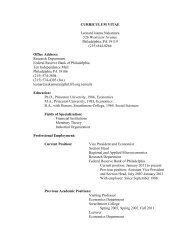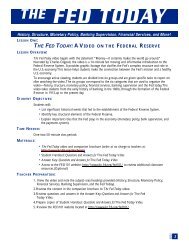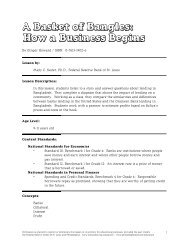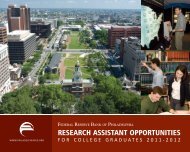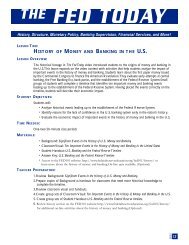The First Bank of the United States - Federal Reserve Bank of ...
The First Bank of the United States - Federal Reserve Bank of ...
The First Bank of the United States - Federal Reserve Bank of ...
You also want an ePaper? Increase the reach of your titles
YUMPU automatically turns print PDFs into web optimized ePapers that Google loves.
clearly in <strong>the</strong> <strong>First</strong> <strong>Bank</strong>’s interactions with state<br />
banks. In <strong>the</strong> course <strong>of</strong> business, <strong>the</strong> <strong>First</strong> <strong>Bank</strong><br />
would accumulate <strong>the</strong> notes <strong>of</strong> <strong>the</strong> state banks and<br />
hold <strong>the</strong>m in its vault. When it wanted to slow<br />
<strong>the</strong> growth <strong>of</strong> money and credit, it would present<br />
<strong>the</strong> notes for collection in gold or silver, <strong>the</strong>reby<br />
reducing state banks’ reserves and putting <strong>the</strong><br />
brakes on state banks’<br />
ability to circulate<br />
<strong>The</strong>se 50 counterfeit $100<br />
<strong>First</strong> <strong>Bank</strong> banknotes were certified<br />
as counterfeit by George Simpson, <strong>the</strong> cashier<br />
<strong>of</strong> <strong>the</strong> first <strong>Bank</strong> <strong>of</strong> <strong>the</strong> <strong>United</strong> <strong>States</strong>, after<br />
<strong>the</strong>ir surrender to William C.C. Claiborne, <strong>the</strong><br />
governor <strong>of</strong> <strong>the</strong> Territory <strong>of</strong> Orleans (1804-1812)<br />
and subsequently governor <strong>of</strong> Louisiana from<br />
1812 to 1816. <strong>The</strong> wrapper reads: “Five thousand<br />
dollars in Contourfeit [sic] notes delivered to Mr.<br />
Saul by Governour [sic] Claiborne, examined<br />
& cancelled by me Geo Simpson Jr. Cashr.”<br />
<strong>The</strong> Library Company <strong>of</strong> Philadelphia.<br />
new banknotes. To speed up <strong>the</strong> growth <strong>of</strong> money<br />
and credit, <strong>the</strong> <strong>First</strong> <strong>Bank</strong> would hold on to <strong>the</strong> state<br />
banks’ notes, <strong>the</strong>reby increasing state banks’ reserves<br />
and allowing those banks to issue more banknotes<br />
through <strong>the</strong>ir loan-making process.<br />
In addition, banknotes issued by <strong>the</strong> <strong>First</strong><br />
<strong>Bank</strong> were widely accepted throughout <strong>the</strong> country.<br />
And unlike notes issued by state banks, <strong>First</strong> <strong>Bank</strong><br />
notes were <strong>the</strong> only ones accepted for payment<br />
<strong>of</strong> federal taxes. <strong>The</strong> <strong>First</strong> <strong>Bank</strong>’s branches were<br />
all located in <strong>the</strong> fledgling nation’s port cities.<br />
This made it easier for <strong>the</strong> federal government<br />
to collect tax revenues, most <strong>of</strong> which came from<br />
customs duties. Locating <strong>the</strong> branches in ports<br />
also made it easier for <strong>the</strong> <strong>First</strong> <strong>Bank</strong> to finance<br />
international trade and help <strong>the</strong> Treasury finance<br />
<strong>the</strong> government’s operations through sales <strong>of</strong> U.S.<br />
government securities to foreigners. Fur<strong>the</strong>rmore,<br />
<strong>the</strong> bank’s branch system gave it ano<strong>the</strong>r advantage:<br />
It could move its notes around <strong>the</strong> country more<br />
readily than could a state bank. In fact, <strong>the</strong> bank’s<br />
branches also helped to fund and encourage <strong>the</strong><br />
country’s westward expansion. David Cowen tells<br />
us that “this transportation service did not stop at<br />
<strong>the</strong> coast: it extended far into <strong>the</strong> interior and back<br />
country.” 23<br />
Closing <strong>of</strong> <strong>the</strong><br />
<strong>Bank</strong> <strong>of</strong> <strong>the</strong> <strong>United</strong> <strong>States</strong><br />
Although <strong>the</strong> bank’s charter did not expire<br />
until 1811, discussions about renewing it began<br />
much earlier. In 1808, <strong>the</strong> bank’s shareholders<br />
asked Congress to extend <strong>the</strong> charter. <strong>The</strong> Senate<br />
forwarded <strong>the</strong> request to Secretary <strong>of</strong> <strong>the</strong> Treasury<br />
Albert Gallatin, asking him for comment. Gallatin,<br />
who favored renewing <strong>the</strong> charter and expanding<br />
<strong>the</strong> bank’s capitalization to $30 million (from its<br />
initial capitalization <strong>of</strong> $10 million), did not respond<br />
to Congress until March 1809 —almost a full year<br />
23 See Cowen, p. 139.<br />
<strong>The</strong> <strong>First</strong> <strong>Bank</strong> <strong>of</strong> <strong>the</strong> <strong>United</strong> <strong>States</strong> 9



